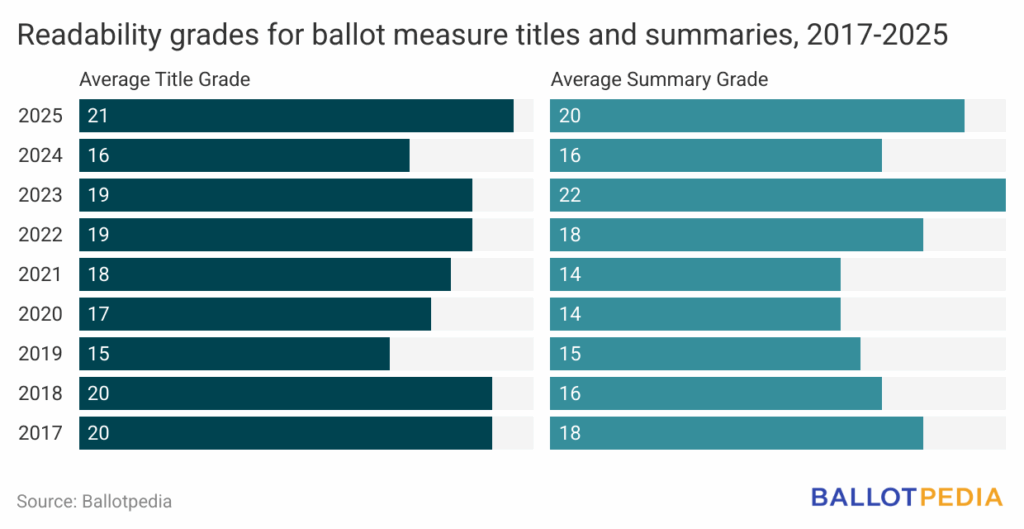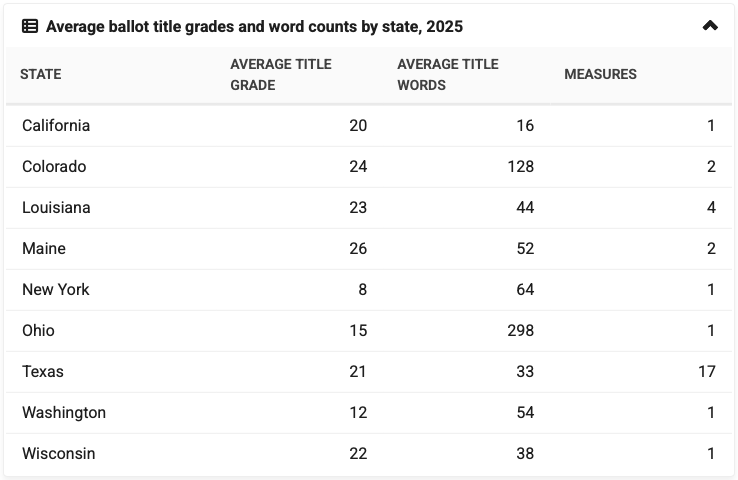The ballot language for the 30 statewide ballot measures in nine states in 2025 is written at an average reading level of 21, equivalent to a doctorate degree, and the highest level since 2017, when Ballotpedia started tracking the data. This is an increase from 2024, which had an average of 16 years of education (bachelor’s degree) and 19 years of education (graduate school level) in 2023.
Ballotpedia's readability report offers insights into the educational level voters might need to comprehend statewide ballot measure titles and summaries.
Using the Flesch-Kincaid Grade Level (FKGL) and Flesch Reading Ease (FRE), the report measures how accessible these texts are based on objective factors, such as the number of syllables, words, and sentences in a text. It's important to note that these scores focus solely on language structure, not the complexity of the ideas themselves.
Below are some highlights from the annual report, which is available here.
Since 2017, Ballotpedia has tracked the readability scores of statewide ballot measures. The following table shows the average ballot title grade, word counts, summary grade, and the number of measures for each year. The year with the lowest ballot title grade was 2019, with 15, and the year with the highest was 2025, with 21.

In 2025, the state with the lowest average grade level for a ballot title or question was New York, with a score of eight years of education for one measure. The highest average score was 26 in Maine, which had two measures on the ballot. The average number of words in a ballot title was 52, ranging from 16 words in California to 298 in Ohio.

The difference in average grade levels between citizen-initiated or legislative measures was six years, with initiatives having an average of 26 years of education and referrals having an average of 20 years. The difference between constitutional and statutory measures was five years, with constitutional amendments averaging 20 years and statutes averaging 25 years.
Since ballot measures often consist of multiple pages of legal text, each state assigns a person or group to write a shorter title for voters to read on the ballot. Those who write the ballot titles include attorneys general, secretaries of state, lieutenant governors, state boards, state legislatures, or the initiative proponents themselves. State boards had the lowest average title grade for 2025, with 12 years of education for two measures. Measures with titles written by secretaries of state had the highest average title grade, with 26.
Only one measure, California Proposition 50, of the 2025 statewide measures also included a ballot summary in addition to the ballot question. The reading levels for Proposition 50’s ballot question and summary were each 20 years of education.
The following individual ballot measures had the highest or lowest grade level scores or word counts:
- The ballot measure with the highest ballot title grade level, at 39, was Louisiana Amendment 2, which proposed several changes to tax and budget policies. While no formal education level, including post-graduate, corresponds to a 39th-grade level, this indicates that the language structure is advanced or difficult, based on the FKGL.
- The ballot measure with the lowest ballot title grade level, at 8, was New York Proposal 1, a constitutional amendment addressing the Mount Van Hoevenberg Complex and Adirondack Park. Based on FKGL, this is equivalent to an 8th-grade reading level.
- The longest ballot title, with 298 words, was for Ohio Issue 2, which allowed the state to issue up to $2.5 billion in general obligation bonds to assist local governments in funding public infrastructure improvement projects.
- The shortest ballot title, with 13 words, was for Texas Proposition 16, a constitutional amendment to provide that "persons who are not citizens of the United States" cannot vote in Texas.
Additional reading:


